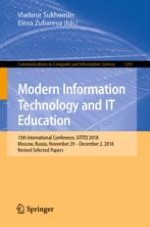2020 | OriginalPaper | Chapter
Algorithm for Optimization of the Content of the Training Course Practical Part Using the Artificial Immune System
Authors : Irina Astachova, Ekaterina Kiseleva
Published in: Modern Information Technology and IT Education
Publisher: Springer International Publishing
Activate our intelligent search to find suitable subject content or patents.
Select sections of text to find matching patents with Artificial Intelligence. powered by
Select sections of text to find additional relevant content using AI-assisted search. powered by
